Top 13 AutomationEdge Alternatives & Competitors in 2024
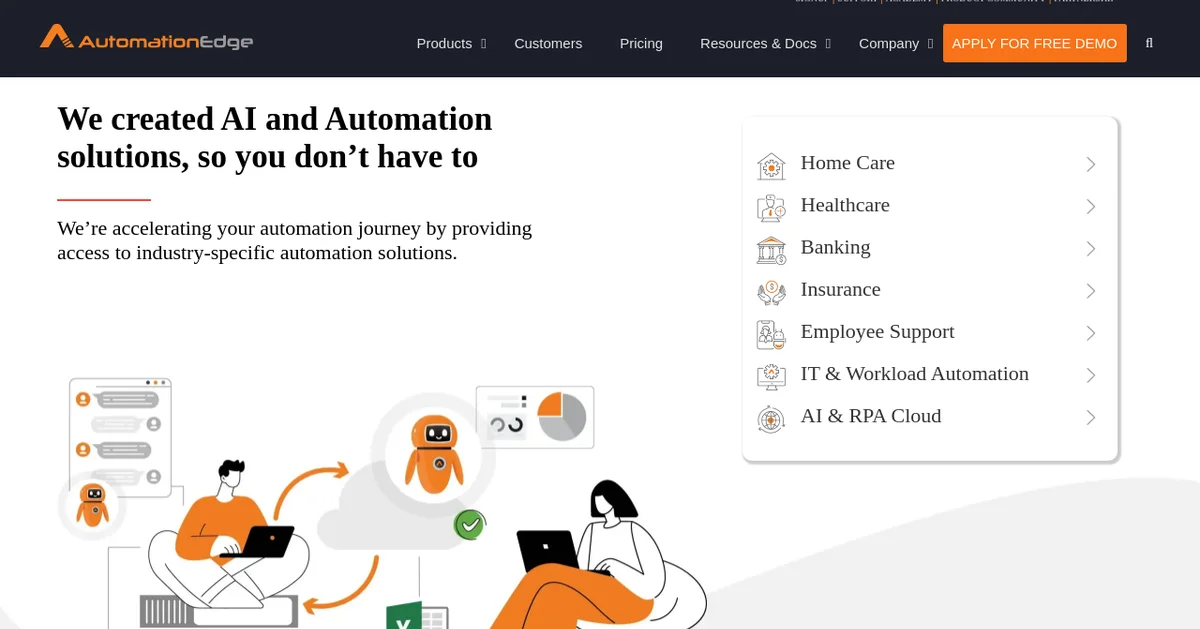
AutomationEdge is a key player in hyperautomation, offering solutions that combine robotic process automation (RPA), IT automation, conversational AI, and document processing. The company stands out for its industry-specific tools designed to help businesses streamline operations in sectors like healthcare, banking, and insurance. Rather than being a one-size-fits-all platform, AutomationEdge prioritizes ready-made solutions tailored to address specific needs, allowing companies to speed up their automation journeys without getting bogged down.
Many organizations, large and small, rely on AutomationEdge for its strong capabilities. Their approach is not just about automating tasks but also improving customer experience and efficiency. From intelligent document processing to automating repetitive tasks, AutomationEdge helps identify and address challenges within various industries. This tailored focus has positioned them as a significant competitor among automation providers, ensuring that businesses have the tools needed to succeed in an automated world.
While AutomationEdge is a great product, it’s always good to shop around and look for alternatives. This article identifies some top competitors and their pros and cons.
UiPath
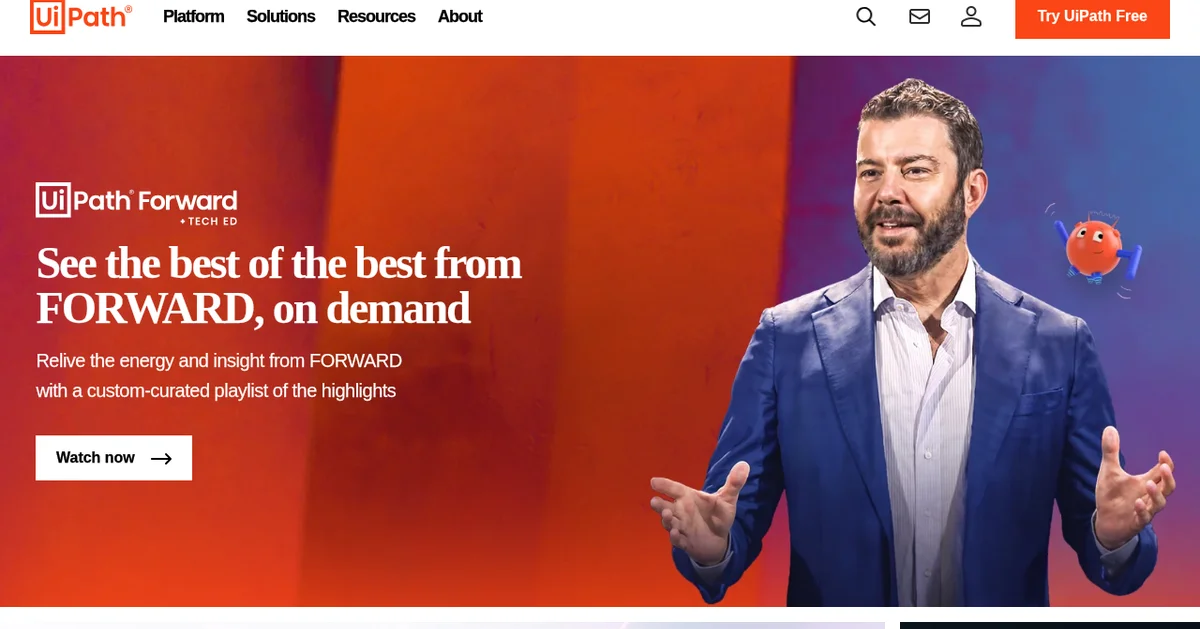
UiPath is a key player in the Hyperautomation space, offering a platform designed for AI-driven business transformation. Founded to make automation accessible, UiPath has positioned itself as a leader by delivering effective and easy-to-use tools. A standout feature is the integration of robotic process automation (RPA) with artificial intelligence (AI), allowing teams to quickly create automation solutions across various technologies.
The company has developed its platform to support “agentic automation,” referring to systems that operate independently and make real-time decisions based on data. This advancement enhances their capabilities and pushes the boundaries of automation beyond many competitors, including alt_13. With a strong focus on improvement, UiPath helps organizations adapt quickly and discover new opportunities using AI.
Their platform serves a wide range of industries, from healthcare to finance, making it suitable for diverse business needs. For example, in healthcare, UiPath helps providers focus more on patient care rather than paperwork, changing how organizations function. Their customer-centric approach has also led to partnerships with major names like Uber and Xerox, demonstrating their effectiveness and reliability.
The benefits of UiPath include ease of use and scalability. Companies can implement solutions quickly, adjusting to changing requirements without extensive downtime or training. This adaptability meets the demands of modern enterprises.
Pros
- Focus on AI-driven automation
- User-friendly interface for rapid deployment
- Versatile applications across industries
- Strong customer support and community
Cons
- Can be costly for smaller businesses
- Steeper learning curve for advanced features
Blue Prism
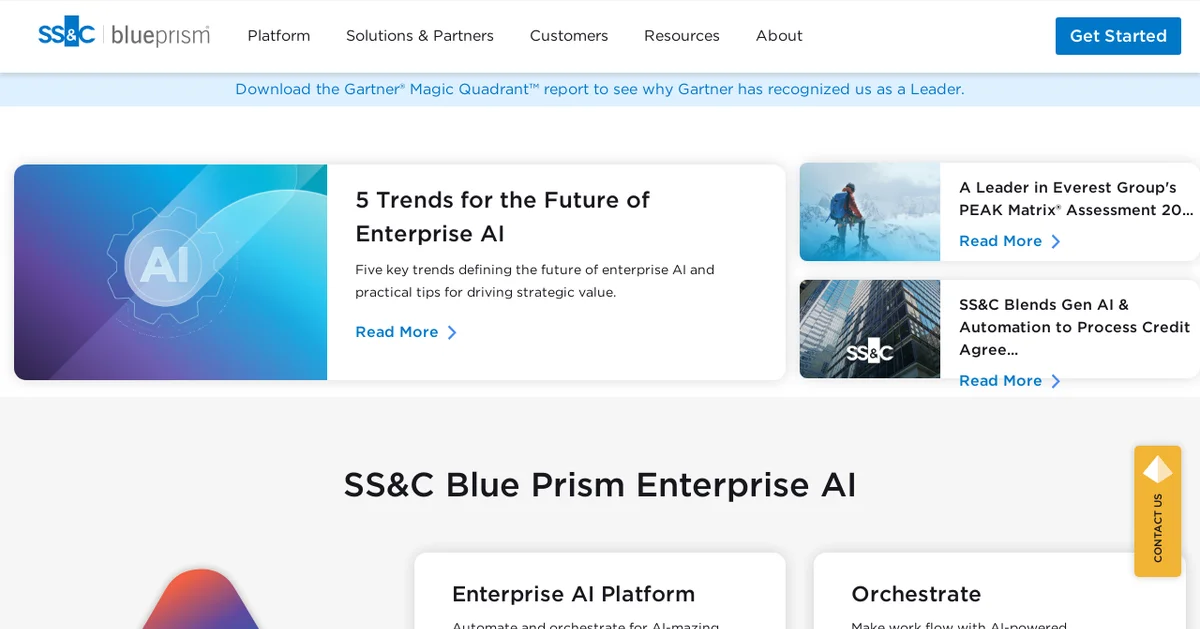
Blue Prism is a leader in hyperautomation solutions, offering a suite of tools to streamline operations through automation and AI. Founded in 2001, the company established itself in robotic process automation (RPA), helping businesses automate repetitive tasks, reduce errors, and save employee time. Their unique offering combines RPA with artificial intelligence, including machine learning and natural language processing, to support smarter business operations.
What sets Blue Prism apart from alternatives like AutomationEdge is its focus on an integrated platform that unifies different aspects of enterprise AI. Rather than providing piecemeal solutions, Blue Prism offers a cohesive experience, enabling organizations to tackle automation across various tasks and processes at once. This approach enhances efficiency while ensuring high standards for quality, security, and governance, which are crucial for managing sensitive data.
Blue Prism’s strategy emphasizes equipping business teams with automation tools, reducing reliance on IT. This self-service model enables quick deployments and easy adjustments, meeting the changing demands of any organization. Their community-driven approach creates a collaborative environment where users can share insights and improvements, ultimately benefiting the platform.
Blue Prism stands out with its comprehensive platform, deep AI integration, and robust user community.
Pros
- Unified platform streamlining multiple automation tasks
- Strong AI capabilities improve traditional RPA functions
- Self-service model enables users across departments
- High security and governance standards in automation
Cons
- Initial learning curve for some users
- Pricing may be higher compared to basic RPA tools
- Implementation can take time based on complexity
Automation Anywhere
Automation Anywhere is a key player in the hyperautomation solutions market. They offer AI agents designed to streamline various business processes including finance, IT, supply chain, and customer service. Their focus on using AI to improve operational efficiency positions them as a reliable alternative to AutomationEdge.
What sets Automation Anywhere apart is its commitment to flexible integration with existing enterprise applications. They provide tools that allow both professional developers and business users to create, manage, and deploy AI agents with low-code solutions. Businesses can customize their automation strategies to fit specific needs without needing extensive programming knowledge. The platform supports any major industry, adapting easily to diverse organizational workflows.
Their AI Model, trained on over 300 million automations, boosts the predictive capabilities of their agents, ensuring accuracy and speed. Businesses have reported a significant reduction in operational costs and time spent on routine tasks. In healthcare, for example, Automation Anywhere’s tools have turned weeks of loan approvals into hours, while also reducing recruitment hours by 85%.
Another important feature is their strong security framework. Automation Anywhere implements user guardrails, data masking, and monitoring, essential for enterprises that handle sensitive information. With their CoE Manager, organizations can maintain oversight and governance across all automation processes, ensuring compliance and security.
Automation Anywhere combines versatility, efficiency, and security, making it a strong alternative to AutomationEdge.
Pros
- Seamless integration with existing applications
- Low-code solution for ease of use
- Highly trained AI agents for accuracy
- Strong security and governance features
- Proven track record of cost savings and efficiency boosts
Cons
- Potential learning curve for new users
- May require upfront investment for scaling
- Limited options for organizations seeking customized solutions
Microsoft Power Automate

Microsoft Power Automate is a tool that simplifies automation for businesses of all sizes. It provides a platform where users can create workflows, automating repetitive tasks without needing extensive coding skills. This accessibility appeals to a variety of users, from developers to non-technical staff.
One standout feature is its integration with a wide range of Microsoft services and third-party applications. Whether working with Excel, SharePoint, or social media platforms like Twitter, users can easily connect their workflows. This flexibility allows teams to combine data and automate processes across their tools.
Power Automate focuses on promoting efficiency and reducing manual errors. By allowing users to set up automated alerts, approvals, and data collection, businesses can save time and resources. The platform also includes AI capabilities, enabling users to analyze data trends and make informed decisions quickly.
The development of Microsoft Power Automate aligns with Microsoft’s goal to improve productivity. By giving users more tools, they aim for a future where automation is seamless and readily available.
Compared to alt_13, which may have a more specialized approach, Power Automate’s extensive ecosystem makes it a strong option for organizations looking to streamline their operations without a complex setup.
Pros
- Easy to use for people with different skill levels
- Strong integration with other Microsoft products
- AI tools to analyze performance and data
- Wide range of pre-built templates to start quickly
Cons
- May lack advanced features for specialized automation needs
- Users may become reliant on Microsoft’s ecosystem
- Pricing model may not fit every budget
Pega
Pega is a major player in hyperautomation solutions, offering a new approach to streamlining enterprise operations. With over 40 years in software innovation, Pega has refined its skills in automating processes and improving customer engagement. They provide a platform that emphasizes personalization and adaptability, allowing businesses to shape their operations based on specific needs.
One notable feature of Pega is its no-code application development. This allows teams to build custom applications quickly without needing extensive technical expertise. Pega’s Blueprint feature enables businesses to articulate their processes in their own language, simplifying knowledge transfer and promoting better collaboration among teams.
Pega serves as a complete solution for enterprises looking to integrate automation into their workflows. By focusing not only on automation but also on providing agility and flexibility, Pega helps businesses respond quickly to market changes. Their solutions cater to various industries, making them an attractive option for organizations with diverse operational needs.
While Pega has strong capabilities in hyperautomation, it’s important to consider its strengths alongside other options, such as alt_13. Users often report a smooth implementation process and solid customer support, improving the experience. Some users may find the learning curve for maximizing Pega’s features challenging.
Pros
- No-code development for quick application creation
- Pega Blueprint supports easy process documentation
- Strong emphasis on personalization and customer engagement
- Adaptable features across multiple industries
Cons
- Learning curve may be steep for full use
- Implementation may take significant time and resources
- Cost can be a factor based on usage scale
Appian
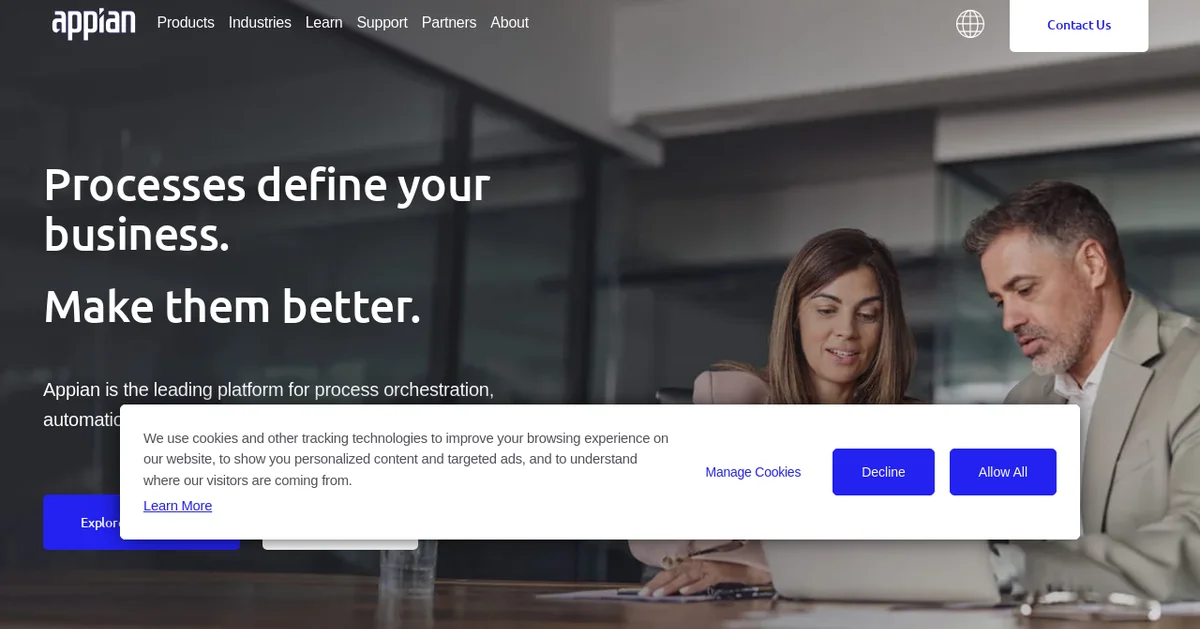
Appian stands out in the hyperautomation landscape as a leader, particularly known for its low-code application platform. The company has been recognized in the 2024 Gartner Magic Quadrant, marking it as a top player in the enterprise low-code space. Appian aims to change business processes through process orchestration and data integration.
One of Appian’s unique features is its focus on combining automation with artificial intelligence. This integration enables users to improve their workflows, allowing businesses to automate tasks and make informed decisions based on AI insights. Their data fabric approach helps unify different data sources, creating a more effective platform. From financial services to public sector initiatives, Appian has successfully automated complex processes, saving clients significant time and resources.
Appian’s narrative is built on a commitment to simplify digital tasks. They offer practical guarantees—like building a process in just eight weeks—that provide confidence to potential users. With a suite of applications that support integration and communication across platforms, their solutions help organizations react quickly to change. For instance, NatWest has automated 46% of its data in governance workflows, while TELUS has saved many man-hours through streamlined operations.
Appian brings distinct strengths to the hyperautomation space—merging low-code development with strong AI capabilities while focusing on process intelligence.
Pros
- Recognized leader in low-code platforms
- Strong integration of AI for intelligent automation
- Fast-track process development guarantee
- Extensive use cases across diverse industries
Cons
- May require a learning curve for some users
- Focus primarily on larger enterprises might limit small business appeal
IBM Robotic Process Automation

IBM Robotic Process Automation (RPA) is an alternative in the hyperautomation landscape, helping businesses streamline operations and boost productivity. This solution leverages IBM’s experience in AI and hybrid cloud technologies, allowing organizations to build and optimize AI applications efficiently.
A key feature of IBM RPA is its integration with AI-driven analytics, enabling businesses to gain insights while automating repetitive tasks. Designed for both technical and non-technical users, IBM RPA is accessible for everyone in the organization. Its intuitive interface allows users to create workflows quickly without extensive coding knowledge.
IBM has a history of innovation and commitment to solving real-world problems. Their approach emphasizes responsible AI, ensuring that automation tools are used ethically and effectively. This focus on sustainability and security enhances their appeal in a market that values transparency and ethical practices.
A defining benefit of IBM RPA is its scalability. Companies can start with simple tasks and gradually implement more complex automation as they grow. This flexibility suits businesses looking for gradual transformation rather than a complete overhaul. Additionally, IBM offers support through its consulting services, assisting organizations in strategy development and implementation.
IBM Robotic Process Automation presents a competitive option for businesses exploring hyperautomation. Its AI integration, user-friendly design, commitment to ethical practices, and scalable approach distinguish it from alternatives like alt_13.
Pros
- AI-driven analytics for valuable insights
- User-friendly interface for all skill levels
- Scalable from simple to complex automation
- Strong focus on ethical AI and sustainability
- Solid consulting support for implementation
Cons
- Initial learning curve for some users
- May seem complex for very small businesses
- Pricing may be higher compared to other options
WorkFusion
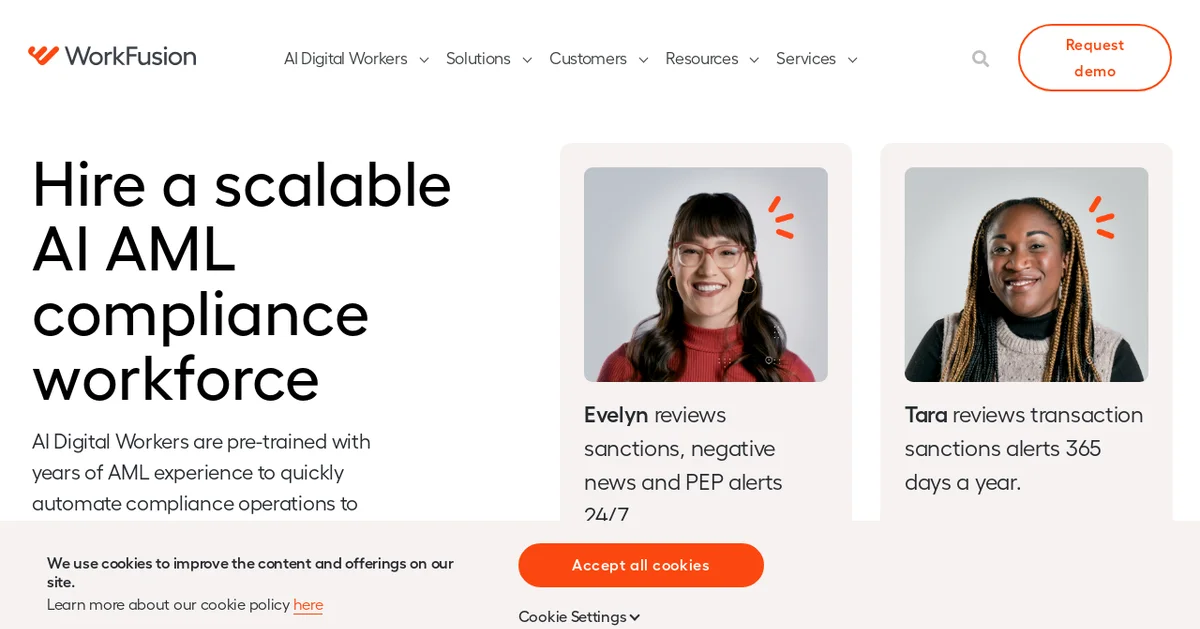
WorkFusion is a key player in hyperautomation, especially in compliance solutions. Founded to change how businesses handle complex operational requirements, WorkFusion focuses on automating tasks related to anti-money laundering (AML) compliance. Their AI Digital Workers mimic experienced analysts and manage repetitive but essential work that often burdens human teams.
What distinguishes WorkFusion from alternatives like alt_13 is their pre-trained digital workforce. These AI agents possess years of AML knowledge, allowing them to perform tasks such as sanctions screening and transaction monitoring with speed and accuracy. This ability enables organizations to grow quickly, meeting compliance demands without the lengthy training for new hires. A notable feature is their explainable AI, which clarifies decision-making processes, essential for financial institutions needing to show strong compliance efforts.
WorkFusion’s solution is not only fast but also cost-effective. The company addresses staffing challenges faced by many financial institutions, particularly in a landscape filled with complex regulations and high compliance costs. Their AI agents deliver consistent performance, reducing human error while freeing up valuable resources for more complex tasks. By improving operational efficiency, they allow analysts to focus on higher-risk areas, supporting overall risk management.
WorkFusion provides a solid alternative to alt_13, particularly for organizations facing AML compliance challenges.
Pros
- Pre-trained AI digital workers cut onboarding time.
- Scalable solution meets growing compliance needs.
- Cost-effective compared to traditional hiring.
- Consistent performance improves operational quality.
- Explainable AI clarifies decision-making.
Cons
- Initial investment may be high for some organizations.
- Dependence on AI may raise concerns about human oversight.
- May need integration with existing systems.
- Not suitable for all types of compliance tasks.
Nintex
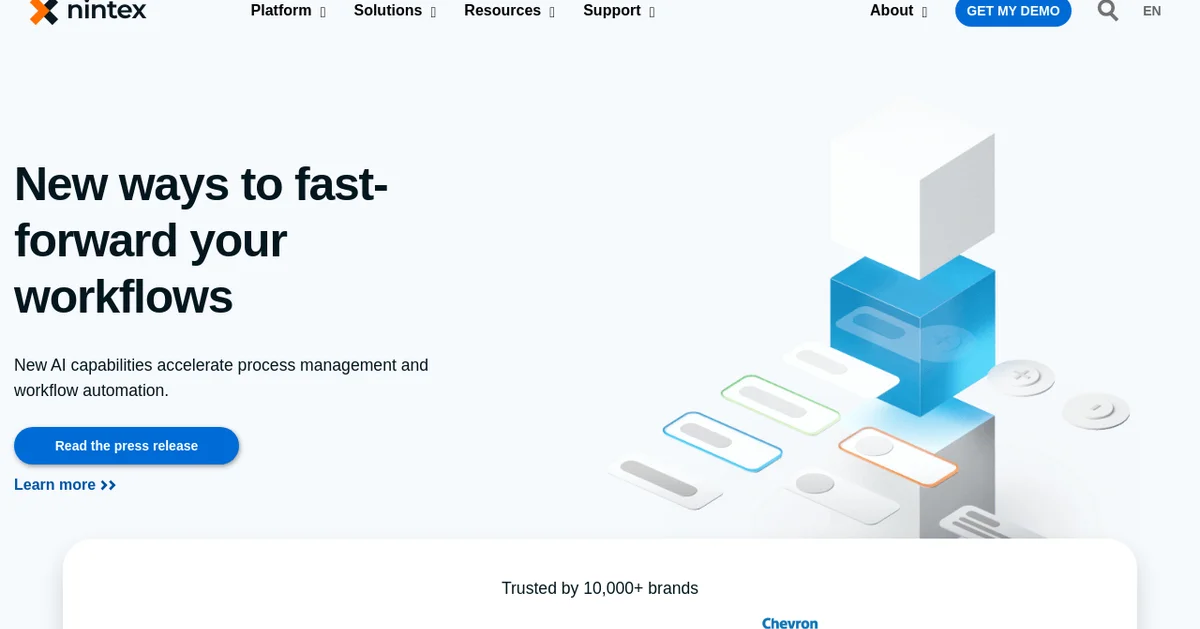
Nintex is a player in the hyperautomation space, known for its suite aimed at streamlining workflows and improving process management. Serving over 10,000 brands, Nintex focuses on making digital transformation straightforward and accessible. Their platform emphasizes process automation, allowing organizations to identify, document, and manage processes efficiently.
With features like Process Identification and Workflow Automation, Nintex stands out by connecting people, processes, and data. They offer cloud-based applications that integrate with existing systems, ensuring a smoother workflow without complicated setups. One unique offering is Forms Automation, which enables businesses to create digital forms for data capture, improving data accuracy and speed in operations.
The story behind Nintex is rooted in solving real business challenges. Their automation technology caters to various industries and processes, from employee onboarding to invoice processing, making it a versatile choice for businesses of all sizes. They provide pre-built templates for processes, workflows, and robotic process automation, making it easier for organizations to start their automation journey and achieve a quicker return on investment.
Nintex offers tools that support automation while promoting visibility and insights into automated processes. Companies looking for user-friendly solutions to improve productivity and efficiency may find Nintex to be a compelling option.
Pros
- Suite for process management
- User-friendly interface and easy integration
- Extensive pre-built templates to start automation
- Focus on visibility and insights
Cons
- May require some learning for complex functions
- Pricing may not be suitable for very small businesses
Kofax
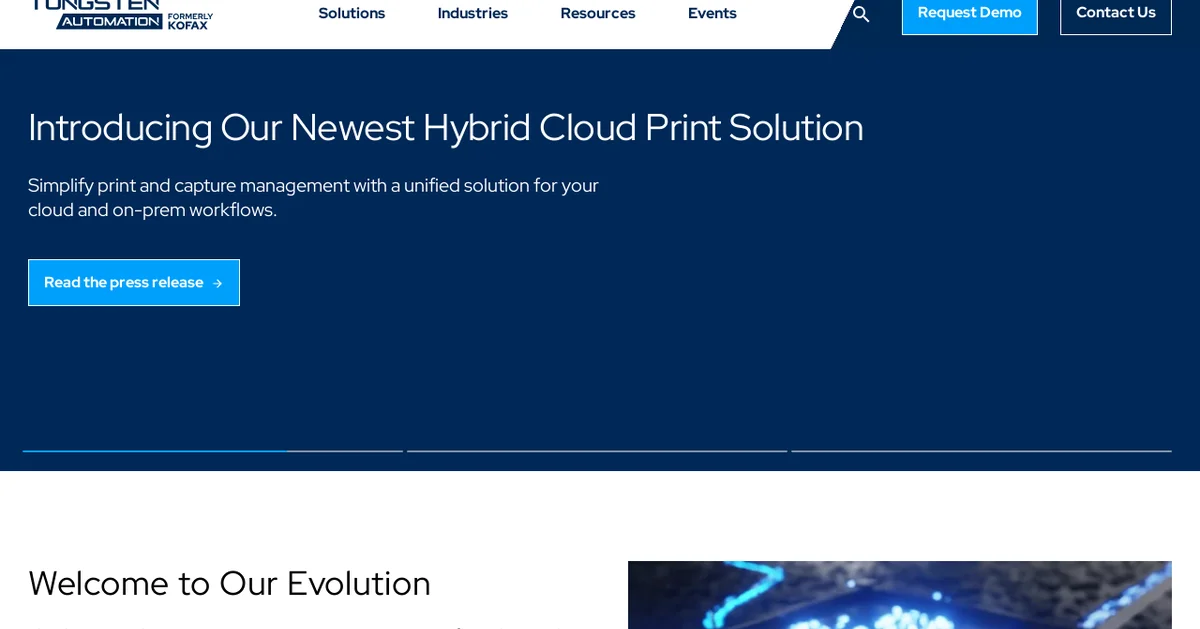
Kofax is a notable player in the hyperautomation field, offering a suite of solutions designed to improve business processes. Their journey began with document management and has expanded to provide strong automation features across industries, including finance, healthcare, and manufacturing. A standout feature is their AI-driven workflow automation, which simplifies tasks related to document processing, data extraction, and invoice management.
Kofax positions itself as a unified platform, highlighting the benefits of integrating multiple automation functions into one solution. This approach differentiates them from alternatives like alt_13, which may offer a more fragmented system. Kofax’s integration capabilities extend to various applications and systems, facilitating smoother data flow and quicker deployment. Their focus on security and compliance also provides reassurance for organizations dealing with complex regulations.
The hybrid cloud print solution is another important innovation from Kofax, allowing businesses to manage print and capture operations smoothly across cloud and on-premises settings. With a strong focus on customer experiences, Kofax serves over 25,000 customers globally, supported by a network of more than 850 partners, making them a trusted name in automation.
Kofax’s combination of document automation, security features, and commitment to integrating various automation processes makes them a viable alternative to alt_13.
Pros
- Comprehensive solutions for document management
- Strong integration capabilities with existing systems
- Focus on security and compliance
- Innovative hybrid cloud print solutions
- Established customer base with many industry awards
Cons
- Potentially higher implementation complexity
- May require more training for users
- Could have a higher price point compared to simpler solutions
SAP Intelligent RPA
SAP Intelligent RPA is a strong option in the hyperautomation field. This solution is built on SAP’s extensive enterprise application suite, offering integration with products like SAP S/4HANA Cloud. This connection lets businesses automate processes across functions, from finance to supply chain management. SAP Intelligent RPA seeks to simplify repetitive tasks, including data entry, report generation, and customer interactions, boosting efficiency and allowing staff to focus on strategic work.
A standout feature of SAP Intelligent RPA is its use of artificial intelligence and analytics. This combination helps organizations automate workflows and improve decision-making with real-time data insights. It has a modular design, enabling companies to gradually scale their automation strategy and add more features as their needs evolve.
The story behind SAP focuses on helping companies innovate and adapt quickly. SAP has built a solid reputation by delivering solutions that fit various industries, accommodating specific challenges. This flexibility, along with strong support and community resources, makes SAP Intelligent RPA attractive for enterprises seeking to improve their automation efforts.
The benefits are significant. Organizations can achieve greater accuracy, improved compliance, and lower operational costs. By streamlining processes, businesses can improve the customer experience and stay agile in their markets.
Pros
- Integration with other SAP products
- AI and analytics for better decision-making
- Modular approach for scalable automation
- Strong support and resources
Cons
- Initial setup can be complex, requiring training
- May be seen as more suited for existing SAP users
Redwood Software
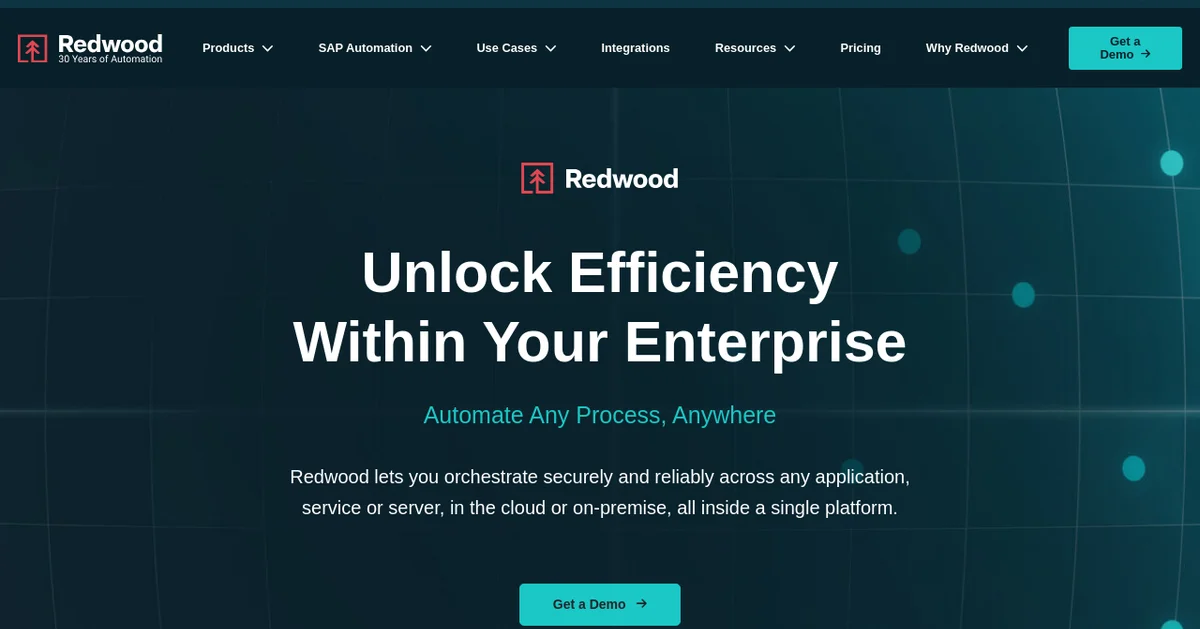
Redwood Software is making a mark in the Hyperautomation Solutions sector with its approach to workload automation. The company has created a cloud-native platform to streamline operations across any application or service, whether in the cloud or on-premise. One of Redwood’s notable features is its native integrations, especially with major ERP systems like SAP and Oracle. This enables businesses to automate processes without being hindered by the limitations of built-in ERP scheduling tools.
The journey of Redwood reflects change and flexibility. The platform addresses current business needs and positions itself for growth. With a low-code development environment, businesses can quickly build and deploy automations using pre-built templates and wizards that simplify the process. This encourages both IT teams and non-technical users to participate in automation.
Security is another area where Redwood stands out. With a single-tenant design and strong encryption measures, businesses can trust that their data is managed carefully. Additionally, the company’s consumption-based pricing model ensures that organizations only pay for what they use, helping to reduce costs and remove expansion barriers.
Redwood Software is notable in the Hyperautomation space for its ability to automate any process, robust integrations, and focus on security.
Pros
- Native integrations improve ERP orchestration.
- Low-code platform speeds up automation deployment.
- Strong security measures provide reassurance.
- Consumption-based pricing leads to reduced costs.
Cons
- Users may need time to fully take advantage of all features.
- Some organizations may prefer on-prem solutions over cloud-native ones.
ABBYY
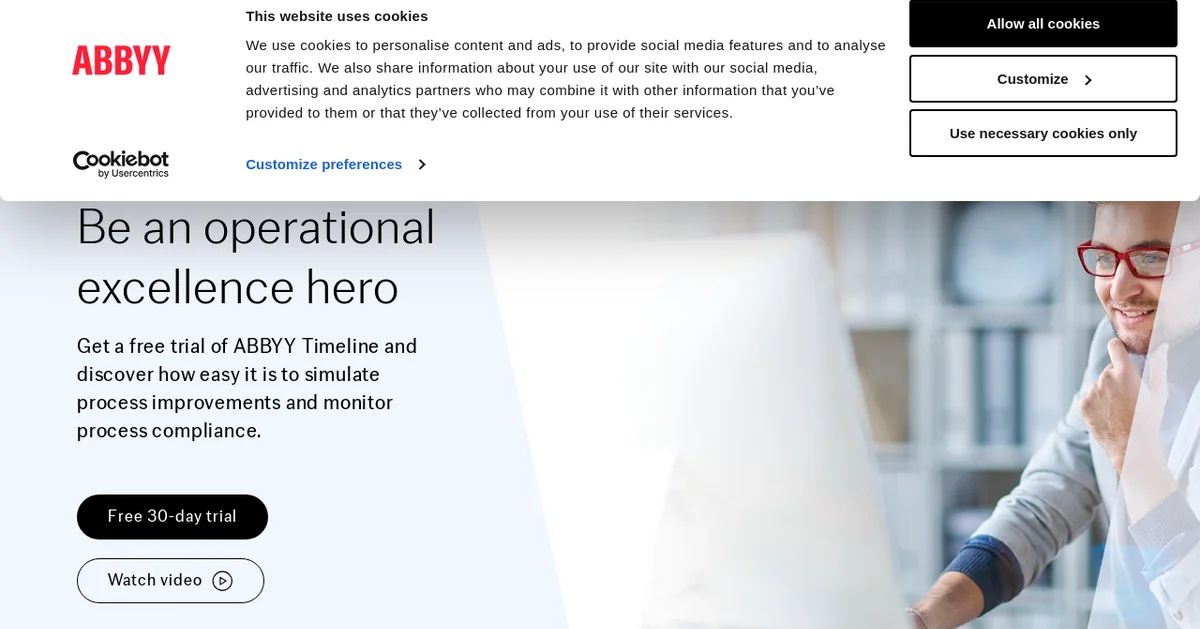
ABBYY has established a significant presence in the hyperautomation landscape with its smart document processing and process mining solutions. The company focuses on converting documents into actionable data, enabling organizations to make informed decisions quickly. With over 35 years of experience, ABBYY is a trusted partner for businesses aiming to improve operational efficiency.
What makes ABBYY appealing is its extensive suite of AI-powered tools that provide ready-to-use extraction models. These models can manage documents in various formats and languages, offering flexibility essential for today’s global businesses. Their process intelligence platform analyzes data to help organizations understand their workflows, identifying bottlenecks and opportunities for improvement. This insight can drive efficiency gains, as seen with clients like the U.S. FDA and Carlsberg, who reported time savings and improved customer satisfaction.
ABBYY’s user-friendly interface allows businesses to start quickly without requiring extensive tech expertise. The combination of low-code functionality and advanced AI capabilities means that even teams without strong programming skills can use the platform effectively.
Exploring alternatives to alt_13, ABBYY stands out for its emphasis on intelligent document processing and powerful analytics. The mix of accessibility, flexibility, and industry knowledge positions ABBYY as a strong contender in the hyperautomation sector.
Pros
- Advanced AI-powered document processing
- Strong process intelligence capabilities
- High capture accuracy and flexibility
- User-friendly, low-code interface
- Extensive industry expertise
Cons
- May require some initial setup and learning
- Pricing structure could be a concern for smaller firms
- Integration with legacy systems might be complex